Often the most important topics we teach are some of the most challenging and difficult to discuss. Because of this, teaching the Holocaust to students of any grade level is a complex task. It is also a vitally important one.
Above all, we want to make sure we provide students with the most accurate and relevant information. But we also must acknowledge the age level of the students we teach. It is important to open students’ eyes to the reality of what was lost while maintaining respect for the lived experiences of so many individuals. Therefore, it’s crucial that we model this respect for our students. Finally, we want to show our students how the events of the Holocaust are still so relevant today.
The United States Holocaust Memorial Museum is dedicated to supporting educators who undertake this important work. The Museum’s leading educators and historians have used their renowned collection of primary sources to create historically accurate, relevant resources that support teachers as they encourage students to think critically about the past and their role in the world today. If you are going to be teaching about the Holocaust, these resources will ensure you feel prepared and confident in doing so.
1. Getting Started
These ready-to-use resources have been grouped together to help teachers in several ways. First, they will help teachers just beginning to plan a unit on the Holocaust. Additionally, they will help teachers who have a limited amount of time to teach this important subject.
- Guidelines for Teaching about the Holocaust – Teaching the Holocaust requires a high level of sensitivity and keen awareness of the complexity of the subject matter. This resource can provide helpful framing.
- Introduction to the Holocaust – This is a comprehensive one-day lesson plan for teachers who want to introduce their students to the topic but do not have time in their schedules for an entire unit.
- Overview of the Holocaust – For teachers with a small window for a dedicated unit, this link provides lesson plans for both a two-day and four-day unit.
2. Foundational Lessons
These lesson plans introduce key concepts and historical content to students. The lessons utilize primary source materials from the United States Holocaust Memorial Museum’s collections.
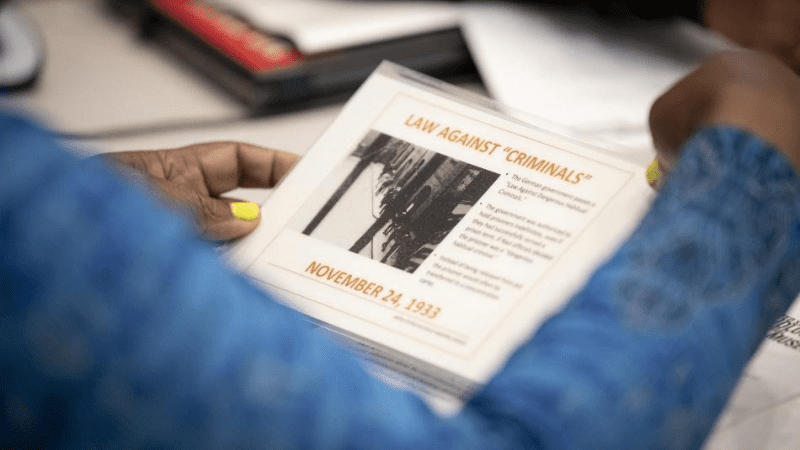
Credit: United States Holocaust Memorial Museum
- The Path to Nazi Genocide Documentary – This 38-minute film provides an overview of how the Nazis came to power in Germany and perpetrated the Holocaust. It does contain difficult imagery and subject matter, so you’ll want to preview it first to make sure it is appropriate for your grade level. The accompanying lesson plan also includes a follow-along worksheet that will help with discussion and reflection after watching.
- Timeline Activity – Students create a multi-layered wall timeline that encourages critical thinking about the relationship between Nazi policy, World War II, historical events, and individual experiences during the Holocaust. Critical thinking questions are included to support post-activity discussions.
- Teaching Materials by Topic – A multi-faceted resource for educators with an already existing unit who are looking to include more authentic, primary sources. Topics include Americans’ response to the Holocaust, how propaganda was utilized by the Nazis during the Holocaust, and more.
3. Teaching Books and Literature: Anne Frank, Elie Wiesel, and Holocaust-era Diaries
Many teachers use novels or memoirs as a window into this topic for students. These resources support lesson plans exploring Elie Wiesel’s memoir, Night, Anne Frank’s Diary of a Young Girl, and others.
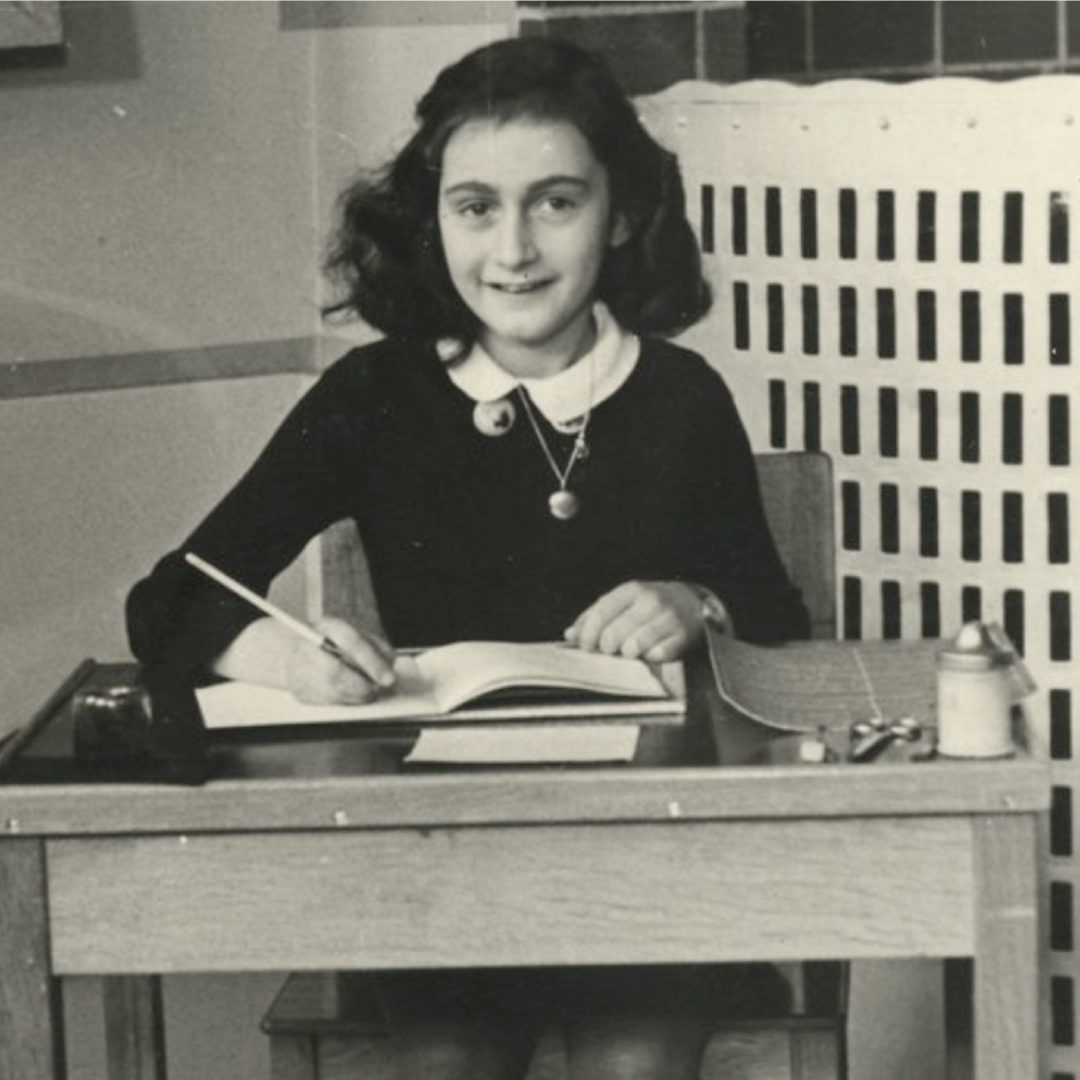
Diarist Anne Frank, 1942. Public domain
- Exploring Night as Literature: Bearing Witness to History – This lesson provides a fuller historical context for the events described in Wiesel’s writing. Additionally, it asks students to examine the purpose of a memoir and the concept of bearing witness. Finally, unique resources allow students to learn about the later life and legacy of Elie Wiesel.
- Exploring Anne Frank’s Diary – In this lesson, students examine Anne Frank’s diary as both a historical and a deliberately-created literary text. Doing so will build understanding about how the Holocaust affected the lives of the Frank family.
- Exploring Holocaust-era Diaries – Suitable for older students who have already read Diary of a Young Girl or as a companion to a unit studying Anne Frank, this lesson looks at other diaries written during the same time period. The primary source material includes actual photos of the diaries as well as PDF versions for easier reading.
4. Examining Antisemitism and Racism
These resources explore the history of antisemitism, the dangers it poses today, and the history behind Nazi symbols and terms.
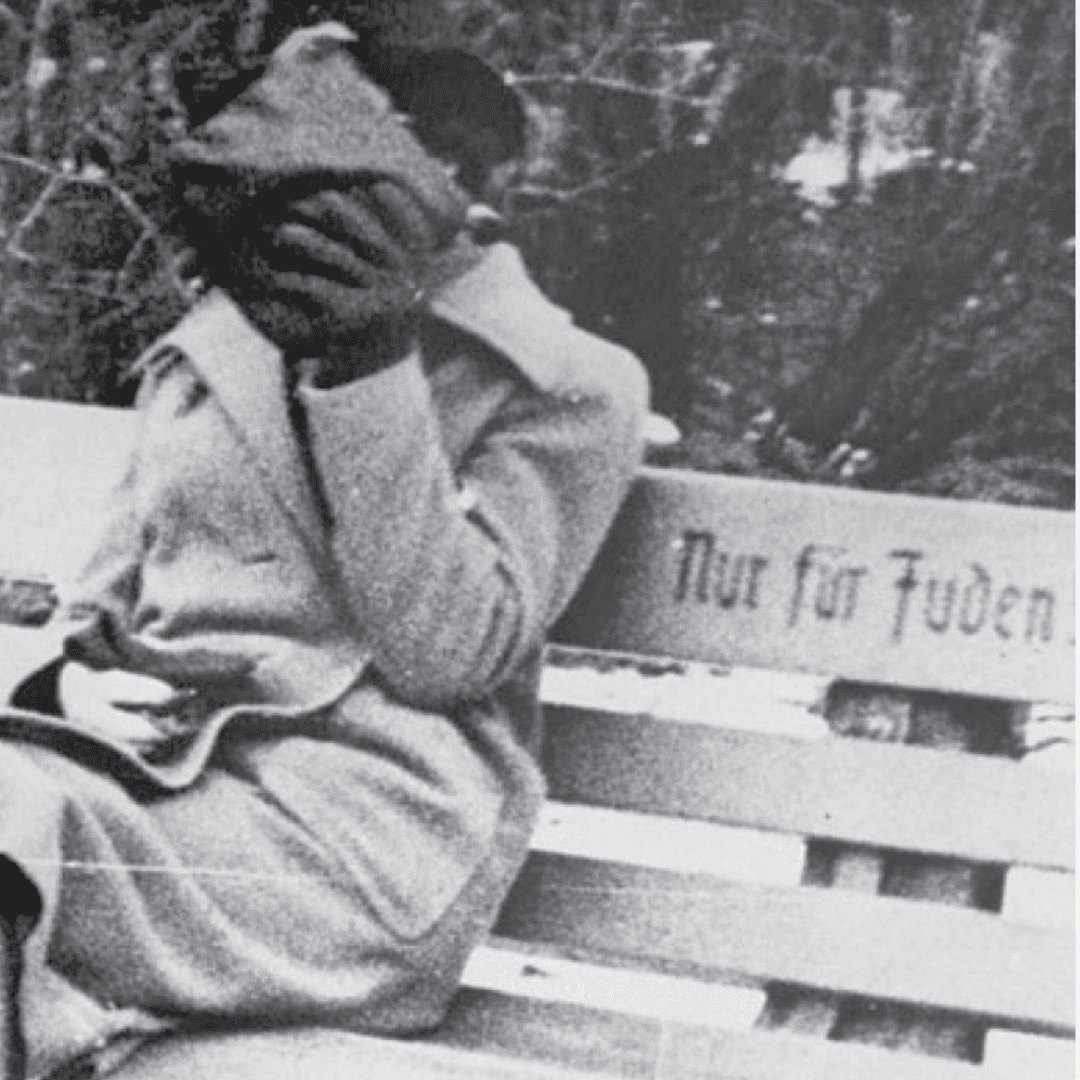
Credit: A woman who is concealing her face sits on a park bench marked “Only for Jews.” Austria, ca. March 1938
- History of Antisemitism and the Holocaust – Students examine the role of antisemitism in the Holocaust to better understand the relationship between hate speech and violence. Learning about the origins of hatred and prejudice encourages students to think critically about antisemitism today.
- Understanding Nazi Symbols – This lesson provides a model for teachers to use when examining the origins of symbols from Nazi Germany as well as how those symbols are used today.
- Nazi Racism – These resources provide an overview for understanding racism in general and Nazi racial antisemitism in particular.
5. Holocaust Videos for Classroom Use
These videos and accompanying lesson plans have been produced by Museum historians and educators for use in middle and high school classrooms to support accurate and effective teaching about the Holocaust.
- European Antisemitism from its Origins to the Holocaust – This 13-minute film introduces the history of antisemitism from its origins through the mid-20th century. It also addresses questions about why Jews have been targeted throughout history and how antisemitism offered fertile ground to the Nazis.
- One Survivor Remembers – Produced by HBO, this film documents Gerda Weissmann’s experiences as a 14-yr old during the Holocaust.
- Behind Every Name – Based on letters and diaries, these animated short videos document five unique, firsthand accounts of the Holocaust.
6. Americans and the Holocaust
These materials examine the motives, pressures, and fears that shaped Americans’ responses to Nazism, war, and genocide. They also provide insight into how much information was available to the American public and the U.S. government about what was happening during this time.

Credit: Jewish refugee children wave at the Statue of Liberty as the SS President Harding Steams into New York harbor in 1939. USHMM, courtesy of Anita Willens
- History Unfolded: U.S. Newspapers and the Holocaust – This interactive lesson guides students through discovering what information about the Holocaust was available in their own community newspapers using online or in-person research.
- Exploring the online exhibition – Students often want to know what Americans knew and what they did during the lead up to the war and during the Holocaust. This online exhibition guides them through this timeframe and poses questions for them to think critically about and discuss as a class.
- Challenges of Escape– While many students may have background knowledge about the Holocaust in Europe, this lesson will focus on the German Jews who tried to emigrate from Nazi Germany and the complex factors that affected their efforts to come to the United States.
7. Survivor Testimony

Credit: Holocaust survivor and Museum volunteer Irene Weiss as a girl, circa 1930-1941 (courtesy of Irene Fogel Weiss), and today
This lesson asks students to examine testimonies of Holocaust survivors via a variety of mediums (videos, diaries, transcripts, and audio). Included activities explore the purpose of oral histories, how testimonies personalize the history and vary from other primary sources, and how we should critically evaluate them as historical sources.
8. Interactive Lessons compatible with Learning Management Systems
The interactive online lessons are compatible with learning management systems or web browsers for students to complete individually or as a class. Perfect for in-person or at-home learning.
- Pre-World War II Jewish Life – In order to better understand what Jewish cultural and communal life was like in Europe before World War II, students will explore the Museum’s digital archive collections, choose photographs of pre-war Jewish life in Europe, and analyze them and the town(s) where the photos were taken.
- Rescue and Survival in Hiding – Using short videos about artifacts in the Museum’s collection, students will learn about the experiences of children and families who survived in hiding during the Holocaust.
- Resistance During the Holocaust – This activity introduces the various forms of resistance during the Holocaust and explores examples from 1933-45.
9. Free, Virtual Professional Learning Conference
Designed to support accurate, meaningful teaching about the Holocaust, the Belfer National Conference for Educators is the US Holocaust Memorial Museum’s flagship event for secondary school educators and invites participants to engage with current historical research and instructional best practices.
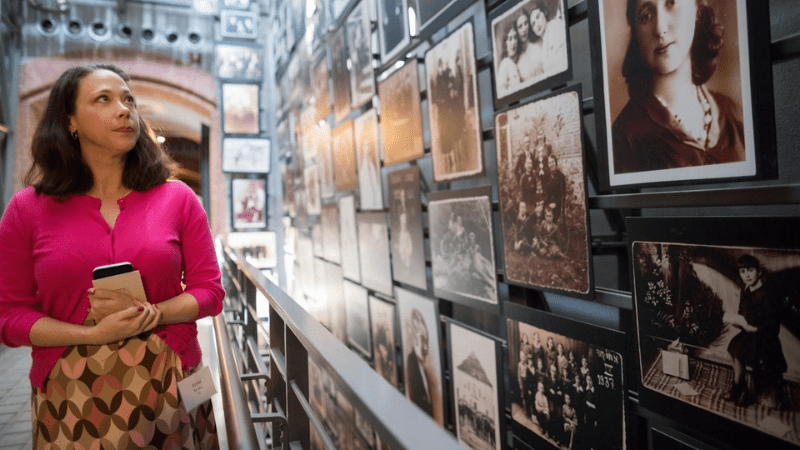
Credit: A visitor looks at photos of daily life before the Holocaust in the Museum’s main exhibition. The Yaffa Eliach Shtetl Collection, US Holocaust Memorial Museum
- On-Demand Professional Learning Videos – Short videos providing guidance on how to teach about the Holocaust.
-
- Historical Connections – This video covers how teachers can help their students make appropriate connections between the past and present.
- Classroom-ready Lessons – This video walks teachers through key resources, a bibliography, lessons for distance learning, foundational lessons, one-day, and multi-day overviews/introductions to the Holocaust.
- Timeline Lesson: Discussion of a lesson that helps students contextualize what was going on historically through studying laws, events, and individual stories.
-
10. Free Resources by Request
The Museum offers educators several resources for their lessons. Teachers can order hard copies of these resources or download them. Some of the materials available include:
- Path to Nazi Genocide DVD
- Days of Remembrance DVD
- Timeline Activity
- Poster Sets
11. FAQs
This collection of commonly asked questions was developed with educators in mind. It will help you address student questions about historical content.
12. Holocaust Encyclopedia
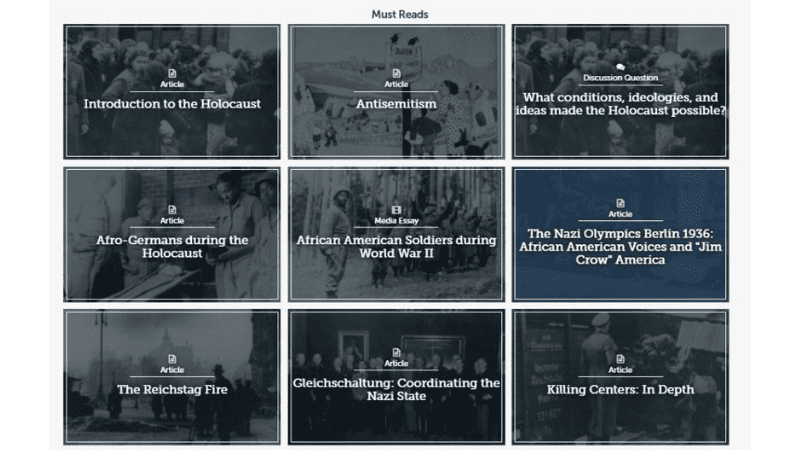
The Museum’s Holocaust Encyclopedia provides hundreds of articles about how and why the Holocaust happened. It includes access to digitized collections, critical thinking and discussion questions, lesson plans, oral histories, animated maps, artifact and document images, historical film clips, ID cards, photographs, and audio clips. Additionally, there are 950 articles in English and hundreds of other articles offered in 13 languages, including Spanish, Arabic, Farsi, and Russian.
13. Teaching Materials Using Primary Sources and the Museum’s Collections
The Museum’s Collections document the fate of Holocaust victims, survivors, rescuers, liberators, and others through artifacts, documents, photos, films, books, personal stories, and more. You will also find collections curated by theme and type.
14. Propaganda
These lesson plans explore how propaganda and hate speech were used by the Nazis during the Holocaust. Materials encourage critical analysis of messages and the effects propaganda on people and society both then and now.
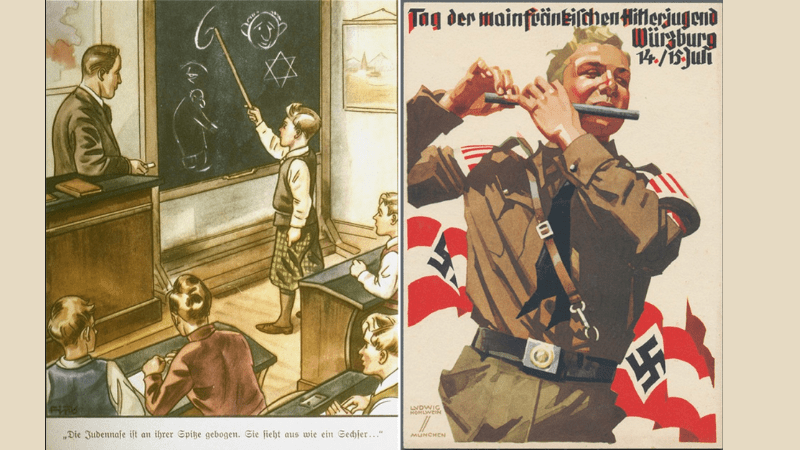
Credit: United States Holocaust Memorial Museum Gift of Helmut Eschwege/ Hohlwein, Wikipedia
- Exploring Nazi Propaganda – This lesson provides opportunities for students to interact interacting with the online exhibition State of Deception to learn about the ways propaganda was used by the Nazis during the Holocaust.
- Critically Analyzing Propaganda – Continuing with analysis of how the Nazis used propaganda during the Holocaust, this lesson furthers critical thinking about how timeless techniques of propaganda are still used today in different contexts.
- Analyzing Memes – Students examine modern memes. Then, they will learn how to unpack the sources and meaning behind the social media they experience every day.
15. Bibliography/Videography
This bibliography provides an extensive list of resources appropriate for the secondary school level and includes diaries, memoirs, secondary sources, literature, graphic novels, and films. In addition, grade and Lexile levels are included whenever possible.
16. Materials in Spanish
The Museum provides foundational materials in Spanish such as:
17. Ask an Educator

Teaching the Holocaust can be daunting. Because of this, the United States Holocaust Memorial Museum is dedicated to providing educators with resources, guidance, and support. To support educators, the Museum answers individual questions you might have about resources and instructional strategies.



